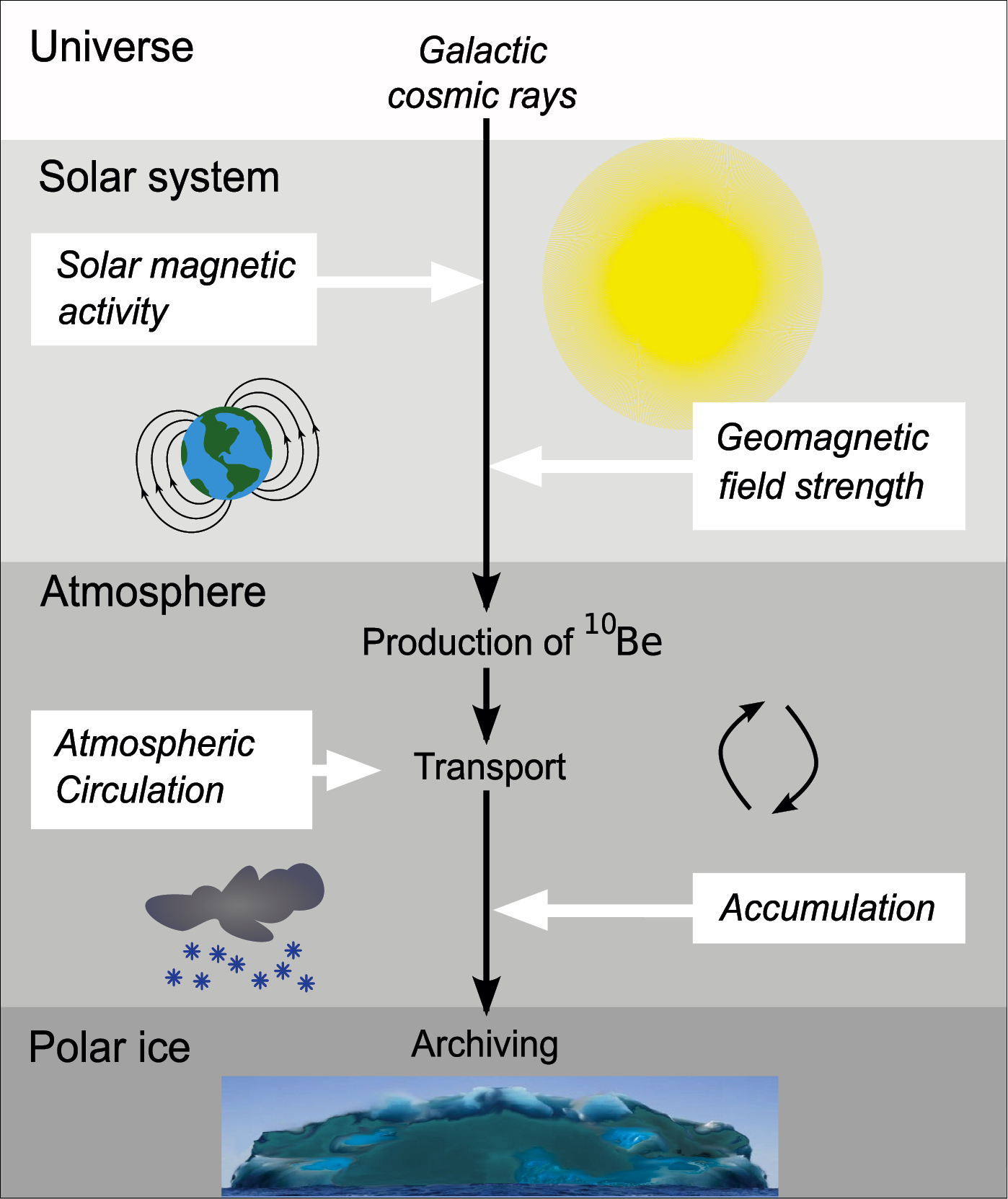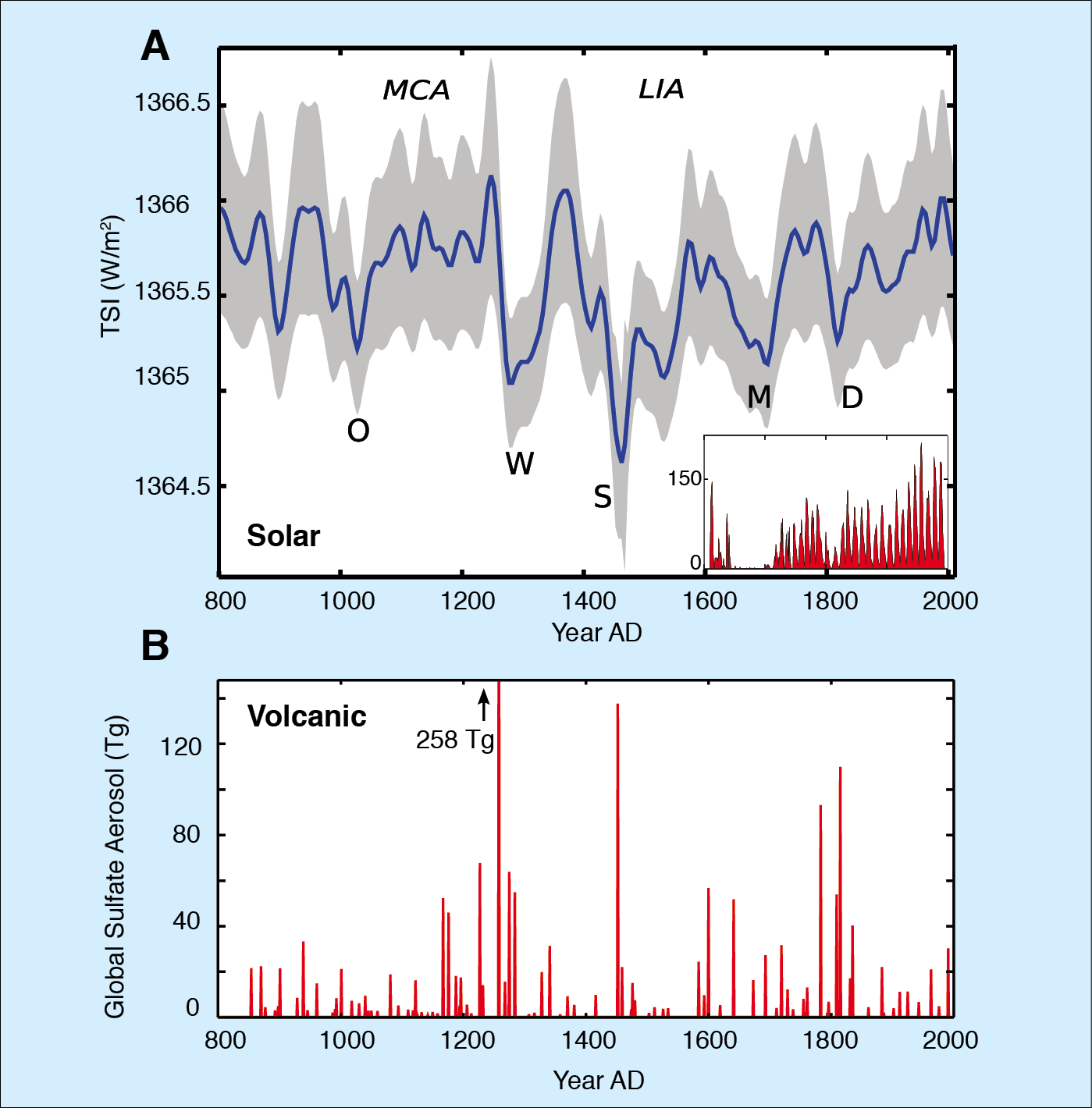- Home
- Publications
- PAGES Magazine
- Solar Activity – The Past 1200 Years
Solar activity – the past 1200 years
Friedhelm Steinhilber and Jürg Beer
Past Global Changes Magazine
19(1)
5-6
2011
Friedhelm Steinhilber and Jürg Beer
Swiss Federal Institute of Aquatic Science and Technology, Dübendorf, Switzerland; friedhelm.steinhilber eawag.ch
eawag.ch
Solar activity highs and lows coincide with the Medieval Climate Anomaly and the Little Ice Age, respectively.
The Sun is a variable star and the most important source of energy for the Earth. This raises the question whether the Sun affects the Earth’s climate. Several solar activity records show that the Sun has short- and long-term variability. An example is the well-known sunspot record (inset curve in Figure 1a), which reaches back to the year 1610 AD, when people started to use the telescope for astrophysical purposes such as observing the Sun. From the sunspot record it is known that solar activity was lower during the 17th and 18th century than today. In particular, the period from 1645 to 1715 AD named the Maunder Minimum (Eddy, 1976) is characterized by a nearly complete absence of sunspots. The sunspot record “only” goes back to 1610 AD and before this time other proxies of solar activity must be used. Presently the only proxies capable of extending the record of solar activity beyond 1610 AD are cosmogenic radionuclides, such as 14C and 10Be. The term “cosmogenic” points to the origin of the radionuclides — cosmogenic radionuclides are produced by nuclear reactions between cosmic ray particles and the gases of the Earth’s atmosphere. Thus, cosmogenic radionuclides record the intensity of the cosmic ray intensity at Earth.
Link to the Sun
 |
|
Figure 2: Illustration of the 10Be system and its relationship to solar activity. |
Why do cosmogenic radionuclides record the solar activity? The link between 10Be and solar activity is illustrated in Figure 2. Cosmic ray particles are accelerated to high energies in the vicinity of supernova explosions in our galaxy. To reach the Earth they have to propagate through the heliosphere, which is formed by the solar wind carrying the solar magnetic field. Cosmic ray particles are charged and therefore get deflected by the solar magnetic field. The larger the strength of the solar magnetic field, the stronger is the deflection of cosmic ray particles and the lower the cosmic ray intensity at Earth. The solar magnetic field is directly related to solar activity, i.e., when solar activity is weak the strength of the solar magnetic field is weak. To summarize, the radionuclide production rate is high during a grand solar minimum like the Maunder Minimum and low during periods of high solar activity. Thus the radionuclide signal principally allows reconstructing solar activity.
In addition to the solar magnetic field, the geomagnetic field also modulates the cosmic ray intensity. From archeointensity data it is known that the geomagnetic field has varied in time (e.g., Knudsen et al., 2008) and therefore a part of the variation found in cosmogenic radionuclides is of geomagnetic origin. Hence, variations of the geomagnetic field must first be removed from the radionuclide record before solar activity can be calculated. The physics-based dependencies between radionuclide production, solar activity and geomagnetic field strength have been determined using the Monte Carlo technique (Masarik and Beer, 2009). These calculations provide the dependence of the radionuclide production on solar activity and geomagnetic field strength. Based on this dependence and the known paleo-geomagnetic field, the solar activity can be derived from the radionuclide signal.
After their production in the Earth’s atmosphere, the radionuclides are transported and distributed within the environment and partly stored in natural archives. The best-suited archives are tree rings (14C) and polar ice (10Be) and both have recorded the solar activity signal with high temporal resolution over many millennia. Tree rings and polar ice can both be dated very accurately, which is a prerequisite for high temporal resolution reconstructions. Some existing records have annual resolution for the past ca. 600 years (Berggren et al., 2009), and resolutions of a few years to decades for the Holocene (e.g., Muscheler et al., 2007; Usoskin et al., 2007; Steinhilber et al., 2008). Note that cosmogenic radionuclides are also found in other archives (e.g., alpine glaciers, lake sediments, ocean sediments) but generally the chronologies are less accurate.
The radionuclide signal not only reflects the cosmic ray variation due to solar and geomagnetic activity, it is also influenced by “system effects”. System effects are variations induced by the transport from the atmosphere where the radionuclides are produced to the ground where they are archived. In addition to the system effects, the cosmic ray signal has uncertainty due to uncertainty in the timescale and in the radionuclide measurements.
Solar activity during the past 1200 years
Recently, total solar irradiance (TSI) has been reconstructed from a composite of several 10Be records measured in polar ice for the past 9300 years (Steinhilber et al., 2008, 2009). The composite is mainly based on the 10Be record from the GRIP ice core, Greenland. As system effects mostly influence the signal on short time-scales, 40-year averages have been built from the 10Be records.
A part of the Holocene TSI reconstruction is shown for the past 1200 years in Figure 1a. Five distinct grand solar minima can be identified known as the Oort (1040-1080 AD), Wolf (1280-1350 AD), Spörer (1460-1550 AD), Maunder (1645-1715 AD), and Dalton (1790-1820 AD) Minima. The last four grand solar minima: Wolf, Spörer, Maunder and Dalton, occurred in a cluster. This cluster coincides with the Little Ice Age (LIA), a period of cold climate conditions from about 1350 to 1850 AD. Between the Oort and the Wolf Minimum a period of high solar activity of approximately 200 years is evident. This period coincides with the Medieval Climate Anomaly (MCA), which is generally characterized by warmer and drier climate conditions. The simultaneous occurrences of the LIA with a cluster of grand solar minima and of the MCA with a long-lasting period of high solar activity, points to an influence of the Sun on the Earth’s climate during these periods. In addition to solar activity, volcanic eruptions played an important role (Fig. 1b; Gao et al., 2008). During the LIA, several strong volcanic eruptions occurred at the time of grand solar minima, which had a further cooling effect. An inverse pattern is found for the MCA when only weak volcanic eruptions are identified and solar activity was high. With the beginning of industrialization in the 18th century, the importance of solar and volcanic forcing decreased while the influence of the anthropogenic greenhouse effect due to fossil fuel burning began to increase and is currently playing the dominant role (Hegerl et al., 2007).
Future solar activity
An interesting question is what role the Sun is going to play in the near future. The 9300-year long composite of solar activity (Steinhilber et al., 2008) shows that during the past six decades the Sun has been in a state of high solar activity compared to the entire period of 9300 years. The statistics of the occurrence of periods of high activity suggests that the current period of high activity will come to an end in the next decades (Abreu et al., 2008). Furthermore, the distribution of grand solar minima in the past 9300 years shows that it is likely that a Maunder Minimum-like period would occur around 2100 AD (Abreu et al., 2010). Such a period of low solar activity would probably lead to a temporary reduction in Earth’s temperature rise due to the anthropogenic greenhouse effect. However, the 9300-year long record shows that in the past a grand maximum has always been followed by a period of high activity, with the very likely assumption that the Sun's future behavior will be similar to that of the past, it is clear that the Sun will not permanently compensate for human-made global warming.
references
Hegerl, G.C., Zwiers, F.W., Braconnot, P., Gillett, N.P., Luo, Y., Marengo Orsini, J.A., Nicholls, N., Penner, J.E. and Stott, P.A., 2007: Understanding and Attributing Climate Change. In: Solomon, S., et al. (Eds), Climate Change 2007: The Physical Science Basis. Contribution of Working Group I to the Fourth Assessment Report of the Intergovernmental Panel on Climate Change, Cambridge University Press.
For full references please consult: http://pastglobalchanges.org/products/newsletters/ref2011_1.html
